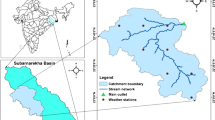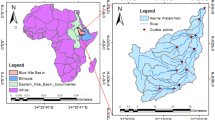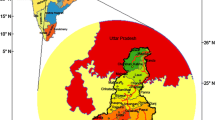Abstract
High soil erosion rates, sediment transport, and loss of agricultural nutrients have been caused by poor land-use practices and management systems. This study mainly focuses on sediment yield modeling and evaluation of best management practices of the Daketa sub-basin using the SWAT model. Calibration and validation were done using the Soil and Water Assessment Tool (SWAT) model in Daketa sub-basin. The coefficient of determination (R2), Nash–Sutcliffe efficiency coefficient (ENS), and percent bias (PBIAS) were used to evaluate the model performance. During the calibration and validation, monthly sediment yield R2 values of 0.80 and 0.85, ENS values of 0.74 and 0.81, and PBIAS values of 0.0829 and 0.124 were obtained. The mean annual sediment yield of the Daketa watershed is 14.43 t/ha/year. Basin management scenarios were applied to reduce sediment production in the sub-basins. Four scenarios were developed such as (i) baseline, (ii) 5 and 10 m wide filter strip, (iii) waterway grass, and (iv) terraces to select the best management practices in the basin. The result shows that grassy waterway reduces sediment yield with an efficiency of 74.6% relative to the baseline scenario. Generally, the results indicated that grass waterways have a high potential for reducing the volume and velocity of runoff, sediments, and agrochemicals from agricultural catchments.







Similar content being viewed by others
Data Availability
All data generated and analyzed during this study are included in this published article.
References
Arnold JG, Srinivasan R, Muttiah RS, Williams JR (1998) Large area hydrologic modeling and assessment part I: model development 1. JAWRA J Am Water Resour Assoc 34(1):73–89
Arnold JG, Moriasi DN, Gassman PW, Abbaspour KC, White MJ, Srinivasan R, Jha MK (2012) SWAT: model use, calibration, and validation. Trans ASABE 55(4):1491–1508
Arnold JM, Brys B, Heady C, Johansson Å, Schwellnus C, Vartia L (2011) Tax policy for economic recovery and growth. Econ J 121(550):F59–F80
Belay T, Mengistu DA (2021) Impacts of land use/land cover and climate changes on soil erosion in Muga watershed, Upper Blue Nile basin (Abay), Ethiopia. Ecol Process 10(1):1–23
Chalise D, Kumar L, Kristiansen P (2019) Land degradation by soil erosion in Nepal: a review. Soil Systems 3(1):12
Chekol DA (2006) Modeling of hydrology and soil erosion of Upper Awash River Basin (p. 235). Göttingen: Cuvillier
Duru U (2015) Modeling sediment yield and deposition using the swat model: a case study of Cubuk I and Cubuk II reservoirs, Turkey (Doctoral dissertation, Colorado State University)
Garcia-Ruiz JM, Beguería S, Nadal-Romero E, Gonzalez-Hidalgo JC, Lana-Renault N, Sanjuán Y (2015) A meta-analysis of soil erosion rates across the world. Geomorphology 239:160–173
Hurni H (1988) Principles of soil conservation for cultivated land. Soil Technol 1(2):101–116
OWWDSE OW (2010) East Hararge & West Hararge Zones Land Use Plan Study Project (Erer Mojo Sub Basin Integrated Land Use Plan). Oromia Land and Environmental Protection Bureau
Pla (2014) Advances in soil conservation research: challenges for the future. Spanish Journal of Soil Science, PP 279
Roy P, Chakrabortty R, Chowdhuri I, Malik S, Das B, Pal SC (2020) Development of different machine learning ensemble classifiers for gully erosion susceptibility in Gandheswari Watershed of West Bengal, India. Mach Learn Intell Decis Sci 1–26
Sadeghi SHR, Jalili K, Nikkami D (2009) Land use optimization in watershed scale. Land Use Policy 26(2):186–193
Semmahasak S (2014) Soil erosion and sediment yield in the tropical mountainous watershed of northwest Thailand: the spatial risk assessments under land use and rainfall changes (Doctoral dissertation, University of Birmingham)
Tesfahunegn GB, Vlek PL, Tamene L (2012) Management strategies for reducing soil degradation through modeling in a GIS environment in northern Ethiopia catchment. Nutr Cycl Agroecosyst 92(3):255–272
Author information
Authors and Affiliations
Contributions
All authors contributed to this study, data collection and analysis were performed by Diress Yigezu Tenagashaw, and SWAT model run and result discussion were done by Shame Mohammed Hassen. The manuscript draft is prepared by Bogale Gebremariam.
Corresponding author
Ethics declarations
Consent for Publication
We have submitted the manuscript entitled “Sediment Yield Modeling and Evaluation of Best Management Practices Using the SWAT Model of the Daketa Watershed, Ethiopia” to be considered for publication. We declare that this is our original research work.
Conflict of Interest
The authors declare no competing interests.
Additional information
Publisher's Note
Springer Nature remains neutral with regard to jurisdictional claims in published maps and institutional affiliations.
Rights and permissions
About this article
Cite this article
Hassen, S.M., Gebremariam, B. & Tenagashaw, D.Y. Sediment Yield Modeling and Evaluation of Best Management Practices Using the SWAT Model of the Daketa Watershed, Ethiopia. Water Conserv Sci Eng 7, 283–292 (2022). https://doi.org/10.1007/s41101-022-00142-3
Received:
Revised:
Accepted:
Published:
Issue Date:
DOI: https://doi.org/10.1007/s41101-022-00142-3




